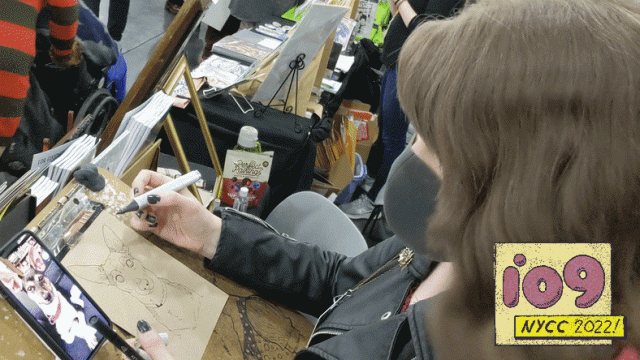The rough bustle of humanity covered every square inch of the New York Comic Con show floor. Among the rows of tables of Artist Alley, it felt more like being driven by a tide rather than an exploration through the minds of some of the most creative people in the comics scene.
Though there were big names at the convention like Kevin Eastman (Teenage Mutant Ninja Turtles) and Jim Lee (Batman and Justice League), who drew huge crowds of rabid fans looking signed copies of popular works, the con-goers who managed to stop by the many indie artists table were often greeted by creators actively working their craft. These artists used a multitude of mediums including inks, watercolors, pencils, markers, and digital tools to craft commissions or parts of larger projects. Compared to many other public art shows, this bounty of creativity on active display may be what makes NYCC’s Artist Alley the most interesting place for any budding artist, or else anybody who’s interested in the creative process.
But beyond the hope to draw people to their tables, these artists were becoming lost in their work. And that begs the question: what goes through an artist’s head while they paint, draw, sketch, and line while surrounded by the manic environment that is NYCC? We asked a few independent artists that very question, letting their stream of conscious guide their words as well as their work.
Many of the artworks shown in the clips are finished and up on the artists’ Instagram pages now, so be sure to click around if you want to see the completed pieces.
Marcus Williams

Who are you?
My name is Marcus Williams, aka Marcus the Visual; you’ll find me online at Marcus the Visual. Oh, man, I’ve always loved art. I’m a character designer, but character design is what I guess excited me to draw all those years when I was a kid. I thought I wanted to do animation, but that’s not really where my excitement comes from. I love creating characters. Looney Tunes, Teenage Mutant Ninja Turtles, Sonic the Hedgehog, Street Fighter, all that was very character driven. That’s what I’m still doing now.
How would you describe your art style?
I’m actually an amalgamation of a lot of people. Bruce Lee had three different masters, right? But eventually, he actually came up with his own version of all of that. And so, as a kid, I tried to draw like everyone I just named. Now collectively, because I studied all of those different styles, I can pull and kind of combine anything I knew from them. And so I come up with something like that [Williams pulls out a print from his “Old Ninjas” series]. Some people can kind of eyeball this and say reminds me of something. But ultimately, it’s a combination.
What’s going through your head as you draw?
What do I want to convey, what kind of energy do I want this to have? It’s almost the same thing a photographer is trying to frame something interesting. But I just focus on character. So any character art that I create, I want it to tell a story, what is going to make someone snap to this? So I guess the construction of this all comes down in anatomy, dynamic energy, things like that. I don’t always think that happens with everyone. You can have a character standing completely still, not doing anything, and still be very engaged.
What is your big current project, and where can people find you?
I’m working with a partner of mine, Greg Burnham, on Tuskegee Heirs. It’s a futuristic sci-fi action adventure set 80 years from now. It features five young pilots who have been trained by the Tuskegee Heirs, but during a time where manned flights are kind of illegal. But the leader of the Heirs feels like they’re gonna have to be the last line of defence against this ominous threat. Turns out, he’s right. So it’s very cool, very anime-inspired, and it looks up to the history of the Tuskegee Airmen. We like what we’re doing is all ages. We’ve been working on it since 2016.
You can find me on my website, Marcus the Visual, and my Instagram.
K. Lynn Smith
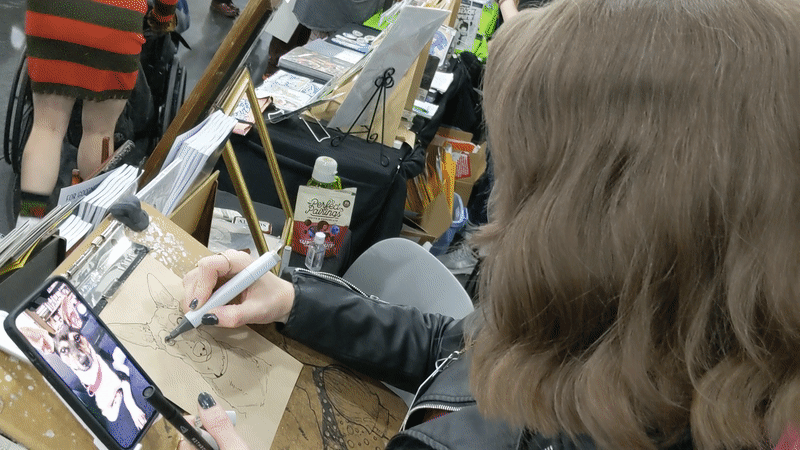
Who are you?
I am K. Lynne Smith. I am an artist and writer, my biggest title is Plume, the Western; [I’ve also been] working on other titles, you know, collaborative work and all that. I got started actually going to school for animation. And I wanted to be an animator. And I created a webcomic to kind of gain traction. And here I am in the comic world. So I kind of stumbled my way into this.
My goal was to become a Disney animator, but that dream quickly died. After learning more about like how studios ran, I realised you were just a number on an assembly line. I kind of changed. I grew up with Disney. I grew up with Don Bluth films like All Dogs Go to Heaven. My favourite series were always animation, you know, shows like Gargoyles and Darkwing Duck. That’s where I wanted to be. But I love the comic world. I’m creating my own world and my own characters. I’m perfectly happy with that.
What have you been doing during the con, and what other projects have you done?
The pet commission thing just sort of fell into my lap. There were just a lot of people asking me to do more and more pet commissions. And I personally just love doing it. It’s fun for me to stand here get paid for drawing animals. After going to school for animation, I created a webcomic to gain traction. My biggest title is Plume, a kind of Western fantasy. Other then that, it’s been a lot of collaborative work.
What are you thinking about while you draw?
My mantra right now is “don’t mess up, don’t mess up.” I know, it’s fun. Because every every animal has a different personality. So yeah, I’m trying to work that personality out to kind of get something unique to this animal. You’re just kind of bouncing back and forth in the Comic Con world where you’re talking to people, and you’re working. So yeah, your thoughts are all over the place. In the beginning it was harder, but it definitely got a lot easier over time. You just got to roll with it.
Where can people find you?
I’m all over social media, including Instagram and Twitter. The easiest way to find me is at klynnsmith.net.
Jonathan Wayshak

Who are you?
My name is Jonathan Wayshak and I‘m a comic book artist and illustrator. I do mostly editing. And what you see here is my personal project called MYOPIA, and basically what I do is I just sketch whatever I want off the top of my head, like this piece, and I put it together as a magazine.
How did you come to appreciate comic art?
Well, visually, I was interested in comics. Obviously, it was something that I had to learn. And I was really young, I was like 10 or 11. And luckily, my library had a lot of old turn of the century kind of comics. So I was exposed to that I fell in love with it very early on.
How would you describe your artistic process? Do you have any inspirations?
Right now? Nothing really. If there’s a process like this, [it] is to just be subconscious and draw what comes to mind. That’s what makes the exercise interesting. You know, it’s like true self expression. There’s nothing to it, no thought about selling. It’s all about just putting a line on paper and that expression.
What I’m doing can change how it goes. It could be like this, or some more simpler pieces. I kind of just do the spectrum, you know. The [H.R. Giger inspiration] is definitely there. I spent my childhood going to bookstores and just looking at the Giger books because at the time I couldn’t afford it
Do you have any big ongoing projects? Where can people find you?
I just finished a project and I can’t speak about, unfortunately, but that will be coming up sometime next year. I have also worked on some mainstream comic issues going back.
You can find me at jonathanwayshak.com. I’m also on Twitter and Instagram.
John Pearson
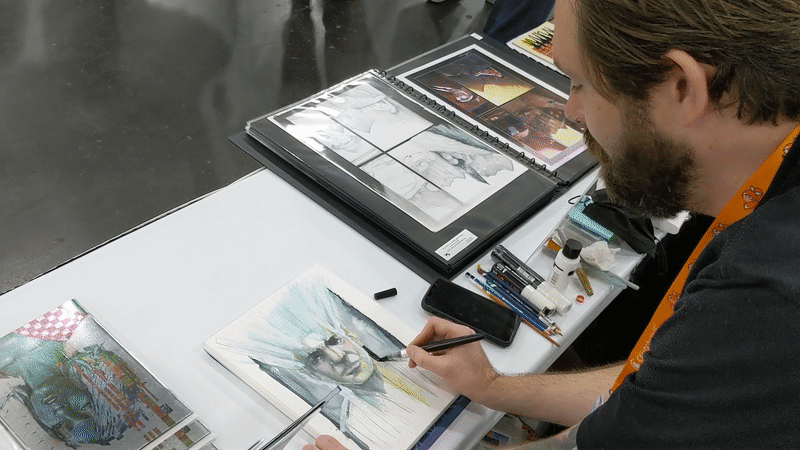
Who are you?
My name is John Pearson. I was always drawn to comics, which is a very age old story, but it was 2000 AD in the UK that I remember seeing these pretty weird things, this mixed medium styles. Looking into more things, I realised comics they’re not all superheroes, and they can be a bit weird and a bit dark and nasty.
What have been your biggest inspirations for your craft?
I studied fine art, and I’ve always liked people like Francis Bacon. I was drawn to expressionism as a way to express mood and emotion, but I’ve mixed [it] with different styles. So I think what I always try to do in comics is think about the mood of the piece, rather than just what it’s showing what the character is feeling, or what I want the viewer to feel. So my style kind of changes quite a bit. It’s quite fluid, and I have a lot of divergent approaches to what I do. But that makes it really interesting is I never quite know what the page might look like. I know the mood that I want, and style of how I’m gonna get there. It’s kind of a journey.
What’s going through your head as you work on this current piece?
I’m kind of going over at the minute and might have been some black contrast for it. So I’m putting black on this side to contrast with the highlights of the face, and then white on that side of the shadows. So at the minute I’m kind of going to build this on top with some black, bring out some white.
I like the cinematic palettes. Cinema is, I suppose, one of my main influences for my colour style. But that kind of goes hand in hand with this idea of motion is one of the key factors. So if you think about emotional intensity, then you’re going to want a lot kind of interesting, right? Kind of poets are looking at disorderly, especially for what I do, which is like a lot of horror stuff or a lot of weird and more unusual stuff.
Where can people find you?
You can find me online at johnpearson.co.uk. I can also be found with @JohnJPearson and my Instagram.
Jasmyn Arnold
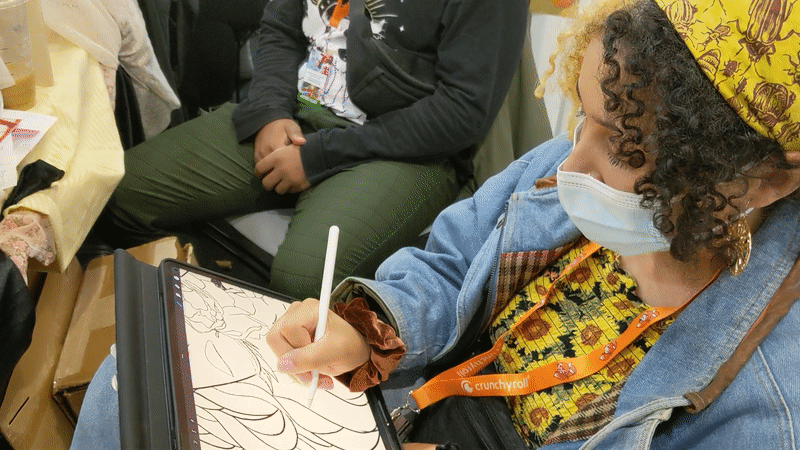
Who are you?
I go by Bottling Sunshine online, like the cool kids. And I’m actually a traditionally trained artist, and I used to do watercolor. Don’t @ me, professors, I did switch to digital. A lot of my work centres on, I don’t know, that brokenness but vulnerability and understanding that it is ok to feel vulnerable. And so I tried to get that across with my theming and things like that.
How did you first get into art?
I was a baby and I used to doodle my cat all the time growing up. I just knew it’s what I wanted. I’d say was about five, and I knew I wanted to do art for a living. When I was nine, my parents didn’t like that too much, which is a very common story but yeah, I’ve drawing all my life. Interestingly enough, I am a college dropout as well. so it’s been an interesting journey. And I can’t wait to do more.
How would you describe your current style?
I’m also a person [who] doesn’t do much rendering. I’m a very much flat kind of person. Like even when I was a traditional artist I did watercolor wash because something that I love is the beauty of lines. I love intricate line work and very fine detail.
I like having my sketches come through with my original liner. I appreciate little mistakes, and I feel like it has like a really beautiful gestural to it and you get a real feel for the process of it all. I felt like you get a little peek in to the artist process and whatnot.
What are you thinking about as you line this piece?
I like something very natural. I’m thinking about how are the lines complementing each other, and it better not be tangent, I hate tangents. I’m just trying to keep that messiness and not trying to keep too much order. Just below in the field, I find shape language to be very important too. So I try to make that a very strong aspect of my work as well. I think it’s like a really good identifier and it catches the eye. I like the movement following the lines that take you everywhere in the drawing.
Where can people find you?
You can find me on Instagram primarily. You can find my website at bottlingsunshine.net.
Marco Rudy
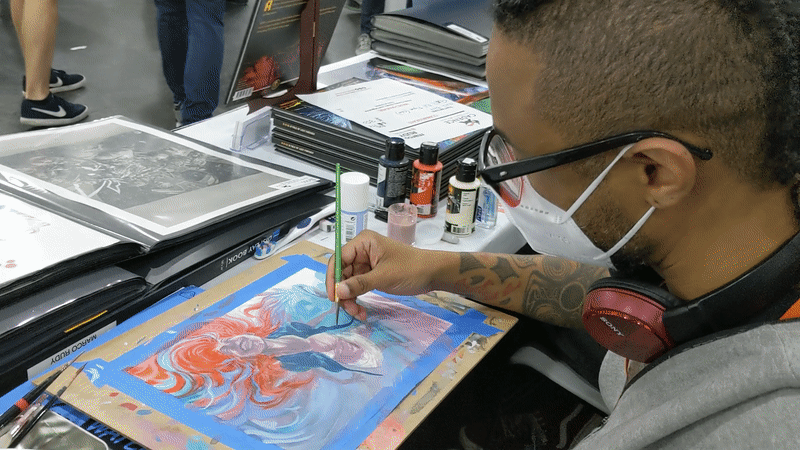
Who are you?
I’m Marco Rudy. I am originally from Mozambique. I started working in comics in 2006, and I have been doing that ever since. I’ve worked with Marvel, DC, Boom, a lot of major publishers, and now I’ve worked for myself, because I’ve painted a book as well. most of my artwork has a very particular approach to visual storytelling, in which I try to engage the reader who looks at the layout and design, because there’s a little more story being told there.
How have you developed your style?
I am very influenced by many, better artists like David Mack, who is also here. The way they do their painterly style is very experimental. Got me to try to do the same on my terms. So I finally arrived at what I can call a quote, unquote, lifestyle, in which I try to use the image to tell the story, not just what’s inside. And mostly, if not all of it, is painted with acrylic.
What is going through your head as you paint?
If I’m working on a page for a book, I am laser focus on what it is that I’m trying to say. So everything in that page or in that sequence has to have a reason to exist. If I’m doing something like this at a convention, I’m going with the flow, wherever the next brushstroke brings me, I follow that. So it depends on what I’m doing and when I’m doing it.
Do you have any big projects that came out recently?
I wrote and painted a book, RDW. It’s a fantasy book all painted in acrylics. I’m currently working on book two.
Where can people find you?
I’m very easy to find online @marcorudy. I have my website at leseditionsxicandarinha.com where you can find a digital edition of my book where you can pay what you want.
Caitlin Yarsky

Tell me about yourself and how you got into art?
My name’s Caitlin Yarsky. I’ve been working in comics for about six or seven years. Well, I was working in video games for a long time and I still do a little bit, but I was not feeling fulfilled in it and I wanted to do something else. So I tried a bunch of different avenues of illustration such as fine art and things like that, and I decided I wanted to try comics. I drew my own 10-page short story and learned about the process, and eventually I was contacted by a writer who wanted to work with me.
How did you develop your current art style?
I feel like my style is always developing, though I know a lot of people say that too, but it really is an ongoing process. I have a lot of different influences and the influences change over time as well. You learn different things, until you know what works. I’m always learning more about composition and anatomy.
What’s going through your head as you sketch out this current work?
Right now I’m figuring out how to reflect this current pose, but overall I tend to think on a bigger scale, about how I want to design the whole page and I’ll move on to the smaller details from there. I want to be comfortable with the overarching work.
Are there any big projects you worked on recently, and how can people contact you?
My first DC book came out recently called Olympus Rebirth which is all about the gods of Olympus and Wonder Woman’s mother, and I also worked on a recent Catwoman issue. Other than that I’ve worked on several series for Dark Horse Comics like Black Hammer.
You can find me at caitlinyarsky.com and @caitlinyarsky on Twitter and Instagram.
